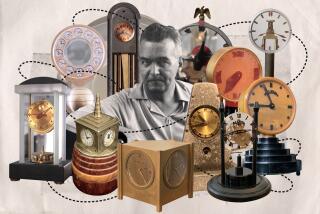Novelty Inventor’s Off-the-Wall Clocks Are a Smashing Hit
Business is booming for Michael C. Copley. Skyrocketing revenues, favorable market analyses, inexorable order increases--all do little but reiterate what is obvious to the 39-year-old La Jolla inventor: He’s hot.
Why?
He couldn’t tell you if his life was riding on it.
“Frankly, I don’t know why my products are doing so well,” said Copley, founder and president of Off-The-Wall, a La Jolla-based novelty gift company. “People love the clocks and watches we make, but sometimes . . . even I wonder why people buy these things.”
Whatever the reason, people do buy Copley’s timepieces--alarm clocks shaped like balls used in the various sports and wristwatches shaped like food. The products have turned up on shelves in major department stores across the country, and Copley recently began shipping them to stores as far away as Australia and Greece.
Off-The-Wall’s sales hit $360,000 in 1986 and jumped to $2.9 million in 1987. Copley figures that revenues will boom during 1988, reaching $5 million.
Take Licking, Keep on Ticking
Copley has generated those figures with products such as Le Munch, plastic wristwatches fashioned after mustard-drenched hot dogs and Oreo cookies.
He also created Half-Time, digital watches encased in miniature replicas of halved basketballs. When tapped, the watches belt out a computerized rendition of “Take Me Out to the Ball Game.”
But Copley’s coup de grace is the Action Alarm Clock, a resilient timekeeper set in small-scale replicas of hockey pucks and balls used in various sports. The well-designed clocks are actually meant to be chucked against bedroom walls by irate sleepers.
The Action Alarm clocks are Copley’s biggest success, outselling the others by almost two to one. They can be found on shelves at J. C. Penney, May Co., Macy’s and Bloomingdale’s.
Copley’s success has baffled some retail observers.
“I defy someone to tell me why things like this sell,” said Leon A. Danco, a noted Cleveland-based observer of small and family-run businesses. “It’s not a rational thing, but the world is always ready for these things--Silly Putty, the Hoola Hoop, the Pet Rock. But they do (sell), and that’s why guys like me are jealous of guys like him. We don’t know how he makes impractical things like this sell.”
Copley’s clocks have “done pretty well here,” according to Bob Kostlan, merchandise manager at Target’s La Mesa store. Kostlan said the clocks sell because “they’re a novelty type item. . . . Other than that I’m not sure. I think history shows that sales for (novelty items) do level off. But, as long as people buy them, we’ll continue to sell them.”
Bedroom Fantasies
Copley figures that his Action Alarm Clocks have succeeded because they cater to one of man’s most consuming bedroom fantasies: “People want to throw their alarm clocks against the wall,” he said. “They get tired of being awakened by this buzzing noise, and they just want to smash it. These Action Alarm Clocks let them throw the clocks as far and as hard as they want. And then they (the clocks) come back for more.”
Still, Copley is aware that nothing--even his Action Alarm--lasts forever. He just hopes Off-The-Wall Products will be around to produce even more bizarre treasures.
“I’d like to stay in the novelty gift industry as long as I can,” he said. “I like creating new products, and I like running my own company. I’m a creative person. I like being an inventor.”
Even so, little about Copley’s appearance suggests more than a shade-tree Edison. Natty, well-tanned and neatly coiffed, he appears more suited to a GQ magazine advertisement than to the rigors of what he terms “a really cutthroat industry.”
And his heritage--he is the son of the late James Copley, patriarch of the Copley newspaper chain--almost steered him into yet another direction. Journalism came close to becoming his livelihood.
After completing high school, Copley went to work for his family’s newspaper chain. When he was drafted into the Army in 1971, he whiled away military duty as the editor of the base newspaper at Ft. Ord, Calif. He became an editor at the Menlo-Atherton Recorder, a Knowles publication, after his graduation from Stanford University in 1977.
But newspapers couldn’t hold his interest for long. Like some seductive siren, inspiration began calling. Michael Copley had clocks to make.
“I had had the idea for the Action Alarm for about eight years,” he said, “but like a lot of people with ideas, I just thought about it. In 1985, I heard on the radio that someone had come up with a similar idea, and I was shattered. Right then, I decided to go full speed ahead with my plans.”
First, though, homework was in order. Copley spent months scanning federal patent documents, safeguarding himself against possible infringements on similar inventions. Finally, though, his careful dance around federal regulations ended.
Borrowed From Banks
“It took me about 18 months, but I got my patent,” Copley said. “Then, I had to find ways of getting the money to get started. I had capitalized the business with $10,000 of my own money and money I had saved over the past 10 years. But, as my sales increased, that’s when I began to run out of money. I had borrowed some money from banks, but that was limited. I couldn’t find other investors. I was walking around in May of 1986 with 200,000 orders and no way to fill them.”
Private financiers, skeptical of his new gizmos, were unwilling to loan money to Copley. And a since-settled legal dispute with his stepmother, Copley newspapers publisher Helen Copley, kept Copley from turning to his family’s vast resources.
“I wanted to do this on my own,” he said.
But, in June, 1986 a friend referred Copley to Roger Gimbel, the president of a novelty products manufacturer in New York.
Gimbel liked Copley’s idea and the two formed a partnership. “We work very well together,” Copley said. “He handles the distributing and I do the inventing and marketing. Roger’s the business side, and I’m the creative side. I run Off-The-Wall, but all decisions are mutual.”
They are decisions that are bringing Off-The-Wall products ever closer to ubiquity, with Action Alarm Clocks and Le Munch watches turning up even in such hotbeds of controversy as South Africa.
“I just want to sell my products anywhere I can,” said Copley, when asked about his business’ relationship with the racist regime. “I don’t want to hurt anyone. I like bringing smiles to people’s faces. If I can do that, wherever, I’m happy.”
And, as the doors to the world marketplace open for the inventor, so do novelty gift ventures.
‘How Dry I Am
“This Christmas, we’re going to market a product called Tom’s Green Thumb for another young inventor,” he said. “It’s a device that’s shaped like a thumb and has a prong on the bottom. You stick the prong portion into a pot with a plant and, when the plant is low on water, the thumb will play ‘How Dry I Am’ until you water it.”
Still, he insisted that he won’t be straying too far from his winning formula. Joining Tom’s Green Thumb will be yet another of those action clocks--this one shaped like a World War II hand grenade.
Said Copley: “We’re marketing it for stressed-out executives. We’ll tell them, ‘Count to 10 and throw.’ I think it ought to do well.”
But he probably won’t spend time wondering why. Michael Copley is hardly one to ponder the dynamics of his good fortune. He’d rather just keep them oiled and running.
Like clockwork.
More to Read
Inside the business of entertainment
The Wide Shot brings you news, analysis and insights on everything from streaming wars to production — and what it all means for the future.
You may occasionally receive promotional content from the Los Angeles Times.










